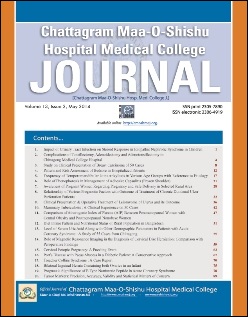Relationship of Various Prognostic Factors with Outcome of Treatment of Chronic Duodenal Ulcer Perforation Patients
DOI:
https://doi.org/10.3329/cmoshmcj.v13i2.21060Keywords:
CDU, perforation, abdominal dyspepsiaAbstract
Background: In acute abdominal conditions, chronic duodenal ulcer perforation is a very common surgical emergency that overwhelm the surgical ward throughout the year. Especially in the tropics and more in our country, peptic ulcer disease causes a major health problem. Objectives: To assess the usefulness of the prognostic factors in terms of morbidity and mortality in the treatment of perforated duodenal ulcer patient.
Methods: This was a prospective study during the period from January 2003 to December 2003 in M.A.G. Osmani Medical College Hospital, Sylhet. The study included 100 cases of perforated chronic duodenal ulcer. Patients were randomly collected from all surgical units of SOMCH, Sylhet. Operation was done by simple closure with omental graft in all cases. Data analyzed by appropriate statistical method (Mean, SD & l2 test).
Results: Highly significant relationship was found between increased age (>50 years) of patients with perforated duodenal ulcer and mortality (p<0.001). Lethality rate was higher in patients operated after 24 hours of onset of symptom in relation to patients operated within 24 hours of onset of symptom, (p<0.05). Different postoperative complications were prevalent in patients operated after 24 hours of onset of symptom, on the other hand complication rate was low in patients operated within 24 hours (p<0.001). There was also longer hospital stay in lately operated patients (more above median) than patients operated within 24 hrs (p<0.001). Mortality was higher in cases of purulent peritoneal fluid, where as it was nil in case of billous and serosanguinous fluid (p<0.001). More complications were developed in patients with purulent peritoneal fluid in comparison to billous and serosanguinous nature (p<0.001). There was more mortality in patients with preoperative shock in comparison with no features of shock (p<0.001). More complications were noted in patients with preoperative shock than in patients with no features of shock (p<0.01).
Conclusion: Delayed operation, preoperative shock, more age and gross peritoneal sepsis bear a direct relationship with outcome of treatment chronic duodenal ulcer perforation patients.
Downloads
185
215
Downloads
Published
How to Cite
Issue
Section
License
Authors of articles published in CMOSHMC Journal retain the copyright of their articles and are free to reproduce and disseminate their work.
A Copyright and License Agreement -signed and dated by the corresponding author on behalf of all authors -must be submitted with each manuscript submission.

